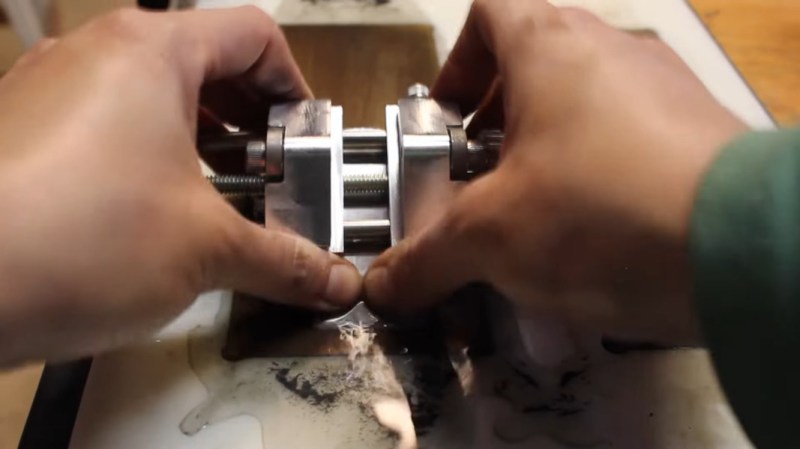[Amy Makes Stuff] has long used a pair of diamond honing blocks to freehand sharpen planes, chisels, and all the other dull things around the shop. Although this method works fairly well, the results are often inconsistent without some kind of jig to hold the blade securely as it’s being sharpened. These types of devices are abundant and cheap to buy, but as [Amy] says in the video after the break, then she doesn’t get to machine anything. Boy, do we know that feeling.
[Amy] was able to make this completely out of stuff she had lying around, starting with a block of scrap aluminium that eventually gets cut into the two halves of the jig. The video is full of tips and tricks and it’s really interesting to see [Amy]’s processes up close. Our favorite part has to be that grippy knob that expands and contracts the jig. [Amy] made it by drilling a bunch of holes close to the outside edge of a circle, and then milled away the edge until she had a fully fluted knob. Once she had the jig finished, she upgraded her honing blocks by milling a new home for them out of milky-white high-density polyethylene.
Mills are fantastic tools to have, but they’re a bit on the pricey side. If you’re just getting started, why not convert a drill press into a mill? Wouldn’t that be more fun that just buying one?
















This is really cool. I made something similar but just use a single screw clamp to hold the tool to the jig, so I have to square it up. This design is way better and I wish I’d thought of it. Time to make a new one.
Could someone explain how the angle of the blade to the stone is controlled with a jig like this? Is it just from how far out you clamp the cutting edge from the jig? Is it done by eye?
Thanks!
The angle depends on how much the blade is sticking out of the jig. The more it sticks out, the shallower the angle. Most people make a simple jig by screwing a wooden stopper block on a board to achieve consistent results.
Gig looks nice. If you’re willing to have it run on the stone. You really don’t want to transfer media from one stone to the other.
The plane blade result she’s happy with still shows the machining marks. That’s just at the point where it can start to get sharp. Chisel was much better.
But then I left stones, honing compounds and diamond pastes behind and use Autosol on a maple blank for sharpening and honing. Mirror surface. Much sharper. Super fast. Crazy low cost.
The only way you remove machining marks is by removing all the surrounding material down to the deepest part of the machining mark.
You’re only going to remove so much material with polish. I’m guessing you don’t get much use out of your tools.
All that sweet machining gear to use a file on part. This one not spark a joy.
Flexure video on the other hand does:
https://www.youtube.com/watch?v=YEz-r8KDY-0
Nice machining, but the device lacks an important feature: simple microadjustment of blade angle. This allows you to hone on a coarse stone for bulk removal, adjust to a slightly steeper angle, and finish the edge with just a couple of strokes on your fine stone.
Very nice. I was thinking of making one just last month. I inherited 7 old planes that were my Grandfathers. Now i have inspiration.